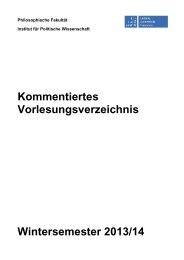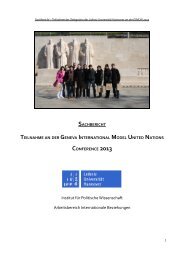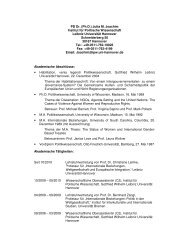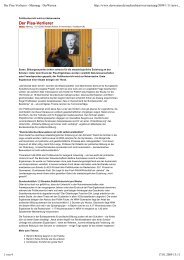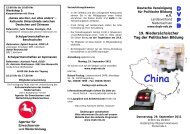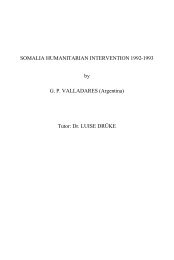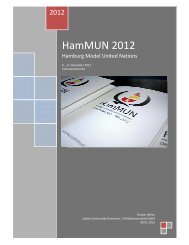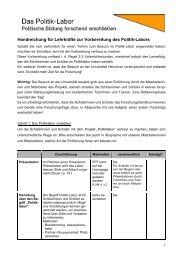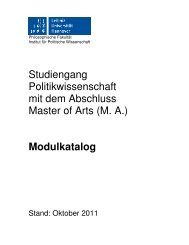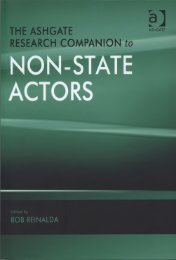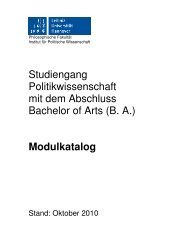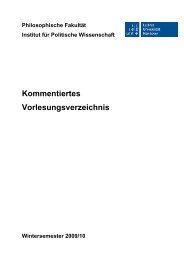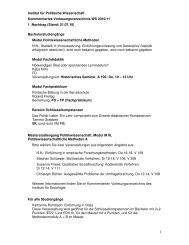Preventive Action for Refugee Producing Situations
Preventive Action for Refugee Producing Situations
Preventive Action for Refugee Producing Situations
You also want an ePaper? Increase the reach of your titles
YUMPU automatically turns print PDFs into web optimized ePapers that Google loves.
136 Chapter 3<br />
increasingly obscure. The U.S. and Vietnamese would bomb particular<br />
areas, after warning people to evacuate through leaflets, radio announcements,<br />
and loudspeaker messages.<br />
Professor Seymour Melman has assembled a number of reports filed by<br />
correspondents of the The New York Times, The Christian Science<br />
Monitor, and Le Figaro to support the claim that the United States pursued<br />
a deliberate policy of creating refugees <strong>for</strong> strategic and military<br />
reasons. 319<br />
George Goss, the head of the U.S. Mission's <strong>Refugee</strong> Division, and Dr. Nguyen<br />
Phuc Que, the Vietnamese <strong>Refugee</strong> Commissioner, agreed that while most<br />
peasants voluntarily left their homes to escape from battles, bombardments and<br />
war, more and more, though, the people called refugees have been <strong>for</strong>ced into the<br />
camps by allied troops to deny support to the Viet Cong workers and soldiers. 320<br />
One correspondent reported that the flight of refugees and the <strong>for</strong>cible resettlement<br />
of people from the Iron Triangle, War Zone C, and the<br />
mountain valleys of Binh Duong province drained the Communists of one<br />
million possible supporters in 1966. 321<br />
Though U.S. Commanders denied that there was a policy of<br />
intentionally generating refugees, one civilian official declared policy or<br />
no, they sure were doing it. Another American official implied that the<br />
U.S. was looking favorably on creating a flow of refugees <strong>for</strong> the purpose<br />
of winning the war. "War is about people," this official said. "The side<br />
that has the loyalty of the people ought to win it. This is a good opportunity<br />
to add a few thousand friends on our side." 322<br />
The intentional generation of refugees sparked reactions among the<br />
civilian population that made the situation worse. Many people developed<br />
a "hamster syndrome" of indiscriminate hoarding, in reaction to the<br />
chronic shortages of critical supplies that were partly due to the highly<br />
centralized governmental relief system. In addition, making the refugees<br />
passive recipients of charity so strained the relief administration that it<br />
was often on the verge of breaking down. The refugee influ into the cities<br />
was a deliberate goal by American strategists, who calculated that this<br />
"<strong>for</strong>ced urbanization," as they termed it, would withdraw peasant<br />
_______________________________<br />
319 Melman, pp. 347-50.<br />
320 Melman, p. 350.<br />
321 Melman, p. 364.<br />
322 Melman, pp. 364-65<br />
Analytical Discussion 137<br />
support from the North Vietnamese and the Vietcong, and thus hamper their<br />
ability to subsist in the countryside. 323<br />
Ambassador Kromer, however, pressed the military commander to "limit the<br />
generation of refugees ... and to assume temporary responsibility <strong>for</strong> those they<br />
created." 324 But some U.S. Force commanders seemed to be particularly resistant<br />
to his suggestions, and went on generating refugees with little regard to what<br />
would become of them.<br />
Post-1973<br />
After the Paris Cease-fire Agreement of January 1973, refugees still fled from<br />
violence in the countryside. The major difference, however, in the post-cease-fire<br />
refugee resettlement program (administered by a Vietnamese Interministerial<br />
Committee) was the avoidance of <strong>for</strong>ced relocation, (out of Communist-controlled<br />
areas), whereas much of the pre-1972 refugee resettlement had been carried out<br />
without the consent of the people relocated. 325 Senator Kennedy repeated his<br />
long-standing policy recommendation that refugee resettlement in Vietnam should<br />
be voluntary and that the movement of people should play no role in U.S.<br />
policy. 326<br />
The Cease-fire Agreement also guaranteed freedom of movement, a right that<br />
was not always honored by either side. 327 The changing balance between South<br />
and North Vietnam had contributed to increased refugee flows into overcrowded,<br />
ever shrinking South Vietnamese-controlled areas. The numbers of refugees by<br />
far exceeded South Vietnam's capacity to absorb them. In accordance with the<br />
1973 Paris cease-fire agreement, many people wanted to return to their homes,<br />
most of which were, however, in Communist-controlled areas. There<strong>for</strong>e the<br />
South Vietnamese authorities prevented this wherever they could. These people<br />
were <strong>for</strong>ced to remain where they were and became a festering sore<br />
___________________________<br />
323 Karnow, 1984, p. 439.<br />
324 Wiesner, (Draft) p. 598.<br />
325 U.S. Congress. Senate. Committee on the Judiciary. Relief and Rehabilitation of War<br />
Victims in Indochina, May 1974. Washington, U.S. G.P.O., p. 16.<br />
326 U.S. Congress. Relief and Rehabilitation of War Victims in Indochina, May 1974, p.<br />
3.<br />
327 U.S. Congress. Relief and Rehabilitation of War Victims in Indochina, 1974, p. 17.



